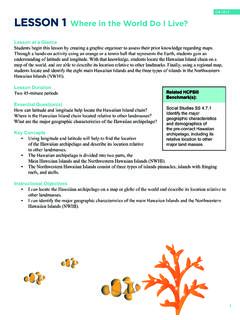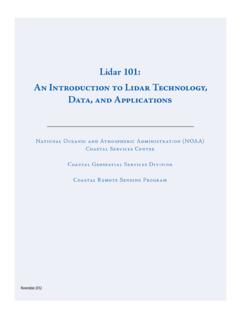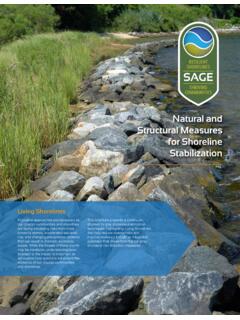Transcription of International Convention for the Safety of Life at Sea ...
1 6/14/13 IMO | International Convention for the Safety of Life at Sea (SOLAS), (SOLAS), 1974 - Brief History -List of amendments to dateand where to find themHistory of Safety at seaHome About IMO C onventions List of C onventions International C onvention for the Safety of Life at Sea (SOLAS), 1974 International Convention for the Safety of Life at Sea (SOLAS), 1974 Adoption: 1 November 1974; Entry into force: 25 May 1980 The SOLAS Convention in its successive forms is generally regarded as the most important of allinternational treaties concerning the Safety of merchant ships. The first version was adopted in1914, in response to the Titanic disaster, the second in 1929, the third in 1948, and the fourth in1960. The 1974 version includes the tacit acceptance procedure - which provides that anamendment shall enter into force on a specified date unless, before that date, objections to theamendment are received from an agreed number of a result the 1974 Convention has been updated and amended on numerous occasions.
2 TheConvention in force today is sometimes referred to as SOLAS, 1974, as provisionsThe main objective of the SOLAS Convention is to specify minimum standards for the construction,equipment and operation of ships, compatible with their Safety . Flag States are responsible forensuring that ships under their flag comply with its requirements, and a number of certificates areprescribed in the Convention as proof that this has been done. Control provisions also allowContracting Governments to inspect ships of other Contracting States if there are clear grounds forbelieving that the ship and its equipment do not substantially comply with the requirements of theConvention - this procedure is known as port State current SOLAS Convention includesArticles setting out general obligations, amendment procedure and so on, followed by an Annexdivided into 12 Chapters.
3 Chapter I - General ProvisionsIncludes regulations concerning the survey of the various types of ships and the issuing ofdocuments signifying that the ship meets the requirements of the Convention . The Chapter alsoincludes provisions for the control of ships in ports of other Contracting II-1 - Construction - Subdivision and stability, machinery and electricalinstallations The subdivision of passenger ships into watertight compartments must be such that after assumeddamage to the ship's hull the vessel will remain afloat and stable. Requirements for watertightintegrity and bilge pumping arrangements for passenger ships are also laid down as well asstability requirements for both passenger and cargo ships. The degree of subdivision - measured by the maximum permissible distance between two adjacentbulkheads - varies with ship's length and the service in which it is engaged.
4 The highest degree ofsubdivision applies to passenger ships. Requirements covering machinery and electrical installations are designed to ensure that serviceswhich are essential for the Safety of the ship, passengers and crew are maintained under variousemergency conditions. "Goal-based standards" for oil tankers and bulk carriers were adopted in 2010, requiring newships to be designed and constructed for a specified design life and to be safe and environmentallyfriendly, in intact and specified damage conditions, throughout their life. Under the regulation, shipsshould have adequate strength, integrity and stability to minimize the risk of loss of the ship orpollution to the marine environment due to structural failure, including collapse, resulting in floodingor loss of watertight integrity. Chapter II-2 - Fire protection, fire detection and fire extinctionIncludes detailed fire Safety provisions for all ships and specific measures for passenger ships,cargo ships and tankers.
5 They include the following principles: division of the ship into main and vertical zones by thermal SOLAS history 6/14/13 IMO | International Convention for the Safety of Life at Sea (SOLAS), (SOLAS), structural boundaries; separation of accommodation spaces from the remainder of the ship bythermal and structural boundaries; restricted use of combustible materials; detection of any fire inthe zone of origin; containment and extinction of any fire in the space of origin; protection of themeans of escape or of access for fire-fighting purposes; ready availability of fire-extinguishingappliances; minimization of the possibility of ignition of flammable cargo III - Life-saving appliances and arrangementsThe Chapter includes requirements for life-saving appliances and arrangements, includingrequirements for life boats, rescue boats and life jackets according to type of ship.
6 The InternationalLife-Saving Appliance (LSA) Code gives specific technical requirements for LSAs and ismandatory under Regulation 34, which states that all life-saving appliances and arrangements shallcomply with the applicable requirements of the LSA IV - RadiocommunicationsThe Chapter incorporates the Global Maritime Distress and Safety System (GMDSS). Allpassenger ships and all cargo ships of 300 gross tonnage and upwards on International voyagesare required to carry equipment designed to improve the chances of rescue following an accident,including satellite emergency position indicating radio beacons (EPIRBs) and search and rescuetransponders (SARTs) for the location of the ship or survival in Chapter IV cover undertakings by contracting governments to provideradiocommunication services as well as ship requirements for carriage of radiocommunicationsequipment.
7 The Chapter is closely linked to the Radio Regulations of the InternationalTelecommunication V - Safety of navigation Chapter V identifies certain navigation Safety services which should be provided by ContractingGovernments and sets forth provisions of an operational nature applicable in general to all ships onall voyages. This is in contrast to the Convention as a whole, which only applies to certain classesof ship engaged on International voyages. The subjects covered include the maintenance of meteorological services for ships; the ice patrolservice; routeing of ships; and the maintenance of search and rescue services. This Chapter also includes a general obligation for masters to proceed to the assistance of thosein distress and for Contracting Governments to ensure that all ships shall be sufficiently andefficiently manned from a Safety point of view.
8 The chapter makes mandatory the carriage of voyage data recorders (VDRs) and automatic shipidentification systems (AIS).Chapter VI - Carriage of Cargoes The Chapter covers all types of cargo (except liquids and gases in bulk) "which, owing to theirparticular hazards to ships or persons on board, may require special precautions". The regulationsinclude requirements for stowage and securing of cargo or cargo units (such as containers). TheChapter requires cargo ships carrying grain to comply with the International Grain Code. Chapter VII - Carriage of dangerous goodsThe regulations are contained in three parts:Part A - Carriage of dangerous goods in packaged form - includes provisions for the classification,packing, marking, labelling and placarding, documentation and stowage of dangerous Governments are required to issue instructions at the national level and the Chaptermakes mandatory the International Maritime Dangerous Goods (IMDG) Code, developed by IMO,which is constantly updated to accommodate new dangerous goods and to supplement or reviseexisting provisions.
9 Part A-1 - Carriage of dangerous goods in solid form in bulk - covers the documentation, stowageand segregation requirements for these goods and requires reporting of incidents involving | International Convention for the Safety of Life at Sea (SOLAS), (SOLAS), Part B covers Construction and equipment of ships carrying dangerous liquid chemicals in bulk andrequires chemical tankers to comply with the International Bulk Chemical Code (IBC Code). Part C covers Construction and equipment of ships carrying liquefied gases in bulk and gascarriers to comply with the requirements of the International Gas Carrier Code (IGC Code). Part D includes special requirements for the carriage of packaged irradiated nuclear fuel,plutonium and high-level radioactive wastes on board ships and requires ships carrying suchproducts to comply with the International Code for the Safe Carriage of Packaged IrradiatedNuclear Fuel, Plutonium and High-Level Radioactive Wastes on Board Ships (INF Code).
10 The chapter requires carriage of dangerous goods to be in compliance with the relevant provisionsof the International Maritime Dangerous Goods Code (IMDG Code).Chapter VIII - Nuclear shipsGives basic requirements for nuclear-powered ships and is particularly concerned with radiationhazards. It refers to detailed and comprehensive Code of Safety for Nuclear Merchant Ships whichwas adopted by the IMO Assembly in 1981. Chapter IX - Management for the Safe Operation of ShipsThe Chapter makes mandatory the International Safety Management (ISM) Code, which requires asafety management system to be established by the shipowner or any person who has assumedresponsibility for the ship (the "Company"). Chapter X - Safety measures for high-speed craft The Chapter makes mandatory the International Code of Safety for High-Speed Craft (HSC Code).









